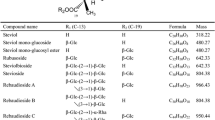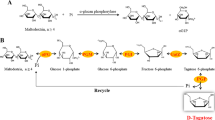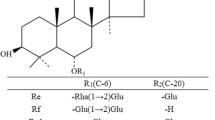Abstract
Objective
To purify and characterize a specific enzyme from a commercial pectinase for the production of steviol from stevioside (Ste) without adding organic solvent and to improve steviol production.
Results
Commercial Sumizyme PX converted Ste to steviol with a yield of 98%. β-Glucosidase from Sumizyme PX (βglyPX) was purified in three steps with 12.5-fold purification and 51% yield. The specific activity of the purified βglyPX was 141 U/mg. The molecular weight of βglyPX was ~ 116 kDa on SDS-PAGE. Its optimum activity was at pH 3.5 and 65 °C. It was stable for 12 h up to 55 °C and for 24 h at pH 2–9.5. K m values of βglyPX for pNPGal, oNPGlc, lactose, and Ste were 2.4, 0.7, 18, and 7.8 mM, respectively. The optimum conditions for steviol production were 55 °C, 900 U/ml, 80 mg Ste/ml, 12 h.
Conclusion
βglyPX contains great potential for industrial steviol production from Ste.


Similar content being viewed by others
References
Capek P, Renard CMGC, Thibault JF (1995) Enzymatic degradation of cell walls of apples and characterization of solubilized products. Int J Biol Macromol 17:337–340
Chen JM, Xia YM, Wan HD, Wang HJ, Liu X (2014) A complete specific cleavage of glucosyl and ester linkages of stevioside for preparing steviol with a beta-galactosidase from Sulfolobus solfataricus. J Mol Catal B-Enzyme 105:126–131
Dekker RF (1986) Kinetic, inhibition, and stability properties of a commercial beta-D-glucosidase (cellobiase) preparation from Aspergillus niger and its suitability in the hydrolysis of lignocellulose. Biotechnol Bioeng 28:1438–1442
Gong GH, Zheng ZM, Liu H, Wang L, Diao JS, Wang P, Zhao GH (2014) Purification and characterization of a beta-glucosidase from Aspergillus niger and its application in the hydrolysis of geniposide to genipin. J Microbiol Biotechnol 24:788–794
Jeppesen PB, Gregersen S, Poulsen CR, Hermansen K (2000) Stevioside acts directly on pancreatic beta cells to secrete insulin: actions independent of cyclic adenosine monophosphate and adenosine triphosphate-sensitive K + -channel activity. Metabolism 49:208–214
Ko JA, Kim YM, Ryu YB, Jeong HJ, Park TS, Park SJ, Wee YJ, Kim JS, Kim D, Lee WS (2012) Mass production of rubusoside using a novel stevioside-specific beta-glucosidase from Aspergillus aculeatus. J Agric Food Chem 60:6210–6216
Ko JA, Ryu YB, Kwon HJ, Jeong HJ, Park SJ, Kim CY, Wee YJ, Kim D, Lee WS, Kim YM (2013) Characterization of a novel steviol-producing beta-glucosidase from Penicillium decumbens and optimal production of the steviol. Appl Microbiol Biotechnol 97:8151–8161
Kohda H, Kasai R, Yamasaki K, Murakami K, Tanaka O (1976) New sweet diterpene glucosides from stevia-rebaudiana. Phytochemistry 15:981–983
Koyama E, Kitazawa K, Ohori Y, Izawa O, Kakegawa K, Fujino A, Ui M (2003a) In vitro metabolism of the glycosidic sweeteners, stevia mixture and enzymatically modified stevia in human intestinal microflora. Food Chem Toxicol 41:359–374
Koyama E et al (2003b) Absorption and metabolism of glycosidic sweeteners of stevia mixture and their aglycone, steviol, in rats and humans. Food Chem Toxicol 41:875–883
Milagre HMS, Martins LR, Takahashi JA (2009) Novel agents for enzymatic and fungal hydrolysis of stevioside. Braz J Microbiol 40:367–372
Nguyen TT, Jung SJ, Kang HK, Kim YM, Moon YH, Kim M, Kim D (2014) Production of rubusoside from stevioside by using a thermostable lactase from Thermus thermophilus and solubility enhancement of liquiritin and teniposide. Enzyme Microb Technol 64–65:38–43
Nguyen TTH, Kim SB, Kim NM, Kang C, Chung B, Park JS, Kim D (2016) Production of steviol from steviol glucosides using beta-glycosidase from Sulfolobus solfataricus. Enzyme Microb Tech 93–94:157–165
Peshin A, Mathur JMS (1999) Purification and characterization of beta-glucosidase from Aspergillus niger strain 322. Lett Appl Microbiol 28:401–404
Prakash I, Dubois GE, Clos JF, Wilkens KL, Fosdick LE (2008) Development of rebiana, a natural, non-caloric sweetener. Food Chem Toxicol 46(Suppl 7):S75–S82
Srimaroeng C, Chatsudthipong V, Aslamkhan AG, Pritchard JB (2005) Transport of the natural sweetener stevioside and its aglycone steviol by human organic anion transporter (hOAT1; SLC22A6) and hOAT3 (SLC22A8). J Pharmacol Exp Ther 313:621–628
Toskulkao C, Deechakawan W, Temcharoen P, Buddhasukh D, Glinsukon T (1994) Nephrotoxic effects of stevioside and steviol in rat renal cortical slices. J Clin Biochem Nutr 16:123–131
Wan HD, Tao GJ, Kim D, Xia YM (2012) Enzymatic preparation of a natural sweetener rubusoside from specific hydrolysis of stevioside with beta-galactosidase from Aspergillus sp. J Mol Catal B-Enzym 82:12–17
Wang Z, Wang J, Jiang M, Wei Y, Pang H, Wei H, Huang R, Du L (2015) Selective production of rubusoside from stevioside by using the sophorose activity of beta-glucosidase from Streptomyces sp GXT6. Appl Microbiol Biotech 99:9663–9674
Yan TR, Lin CL (1997) Purification and characterization of a glucose-tolerant beta-glucosidase from Aspergillus niger CCRC 31494. Biosci Biotechnol Biochem 61:965–970
Zhao LG, Zhou TC, Li X, Fan S, You LJ (2013) Expression and characterization of GH3 beta-Glucosidase from Aspergillus niger NL-1 with high specific activity, glucose inhibition and solvent tolerance. Microbiology 82:356–363
Acknowledgements
This work was partially supported by Korea Institute of Planning and Evaluation for Technology in Food, Agriculture, Forestry and Fisheries (IPET) through High Value-added Food Technology Development Program (1403-20160048) and Agriculture, Food and Rural Affairs Research Center Support Program funded by Ministry of Agriculture, Food and Rural Affairs, Republic of Korea (D. Kim) and by the Basic Science Research Program through the National Research Foundation of Korea (NRF) funded by the Ministry of Education (NRF-2015R1D1A1A01056929; D. Kim, and 2015R1D1A4A01020522; T.T. Hanh Nguyen), under the framework of International Cooperation Program managed by the NRF (2016K1A3A1A19945059; 2016K2A9A2A08003613), and by OTTOGI Corporation through Research and Publication Projects.
Supporting information
Supplementary Fig—1 Steviol standard from thin layer chromatography
Supplementary Fig—2 Effect of time on steviol production from Ste by using crude Sumizyme PX and Cytolase PCL5
Supplementary Fig—3 Effect of temperature (A) and pH (B) on optimum activity and stability of βglyPX
Supplementary Fig—4 Primarily and Lineweaver Burk plots of βglyPX with different substrates
Supplementary Fig—5 Enzymatic hydrolysis of rubusoside, stevioside, rebaudioside, and stevioside glucosides using βglyPX by thin layer chromatography
Author information
Authors and Affiliations
Corresponding author
Electronic supplementary material
Below is the link to the electronic supplementary material.
Rights and permissions
About this article
Cite this article
Nguyen, T.T.H., Seo, C., Gu, BC. et al. Production of steviol from steviol glucosides using β-glucosidase from a commercial pectinase, Sumizyme PX. Biotechnol Lett 40, 197–204 (2018). https://doi.org/10.1007/s10529-017-2460-9
Received:
Accepted:
Published:
Issue Date:
DOI: https://doi.org/10.1007/s10529-017-2460-9




